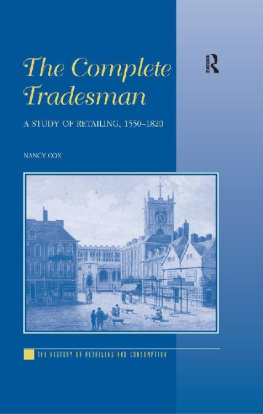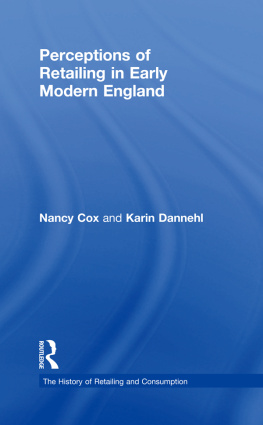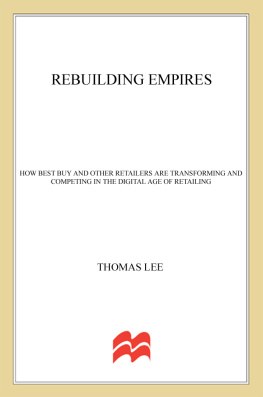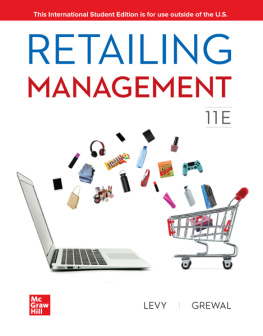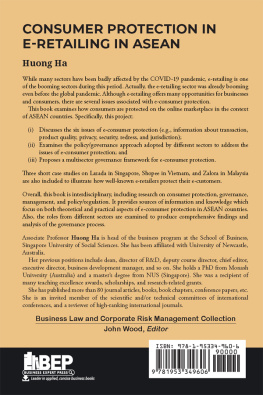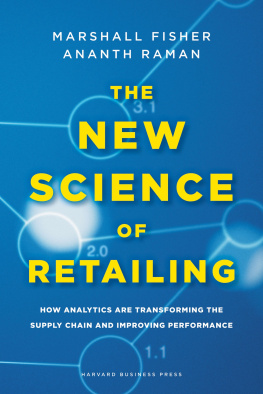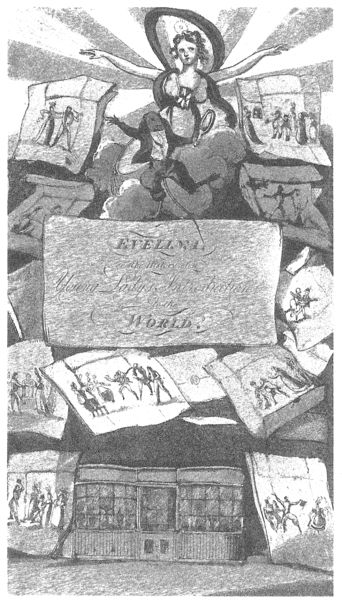
Images of London life, c. 1800. The print is interesting firstly because it indicates how important shops and shopping were in London society life, and secondly because it portrays in symbolic form the external appearance of a fashionable London shop, c. 1800, including large bow windows and a central door with a name board over it.
The Complete Tradesman
A Study of Retailing, 1550-1820
Nancy Cox
First published 2000 by Ashgate Publishing
Published 2016 by Routledge
2 Park Square, Milton Park, Abingdon, Oxon OX14 4RN
711 Third Avenue, New York, NY 10017, USA
Routledge is an imprint of the Taylor & Francis Group, an informa business
Copyright 2000 Nancy Cox
The author has asserted her moral right under the Copyright, Designs and Patents Act, 1988, to be identified as the author of this work.
All rights reserved. No part of this book may be reprinted or reproduced or utilised in any form or by any electronic, mechanical, or other means, now known or hereafter invented, including photocopying and recording, or in any information storage or retrieval system, without permission in writing from the publishers.
Notice:
Product or corporate names may be trademarks or registered trademarks, and are used only for identification and explanation without intent to infringe.
British Library Cataloguing in Publication Data
Cox, Nancy
The Complete Tradesman: A Study of Retailing, 1550-1820.
(The History of Retailing and Consumption)
1. Retail tradeGreat BritainHistory16th century.
2. Retail tradeGreat BritainHistory17th century.
3. Retail tradeGreat BritainHistory18th century.
I. Title.
381.1'0941'09031
Library of Congress Control Number: 00-102015
ISBN 9781859281697 (hbk) ISBN 9781138249950 (pbk)
Transferred to Digital Printing in 2010
It is increasingly recognized that retail systems and changes in the patterns of consumption play crucial roles in the development and societal structure of economies. Such recognition has led to renewed interest in the changing nature of retail distribution and the rise of consumer society from a wide range of academic disciplines. The aim of this multidisciplinary series is to provide a forum of publications that explore the history of retailing and consumption.
Gareth Shaw
University of Exeter
- Frontispiece Images of London Life, c . 1800
Source : Burney (1778, 1812 edition), Evelina .
Photograph by Tony Howell. - 2.1 Shops in the Strand, London, c . 1750
Source : Engraving of Thomas Bowles's 'St Mary le Bow and Cheapside'. By permission of Guildhall Library, Corporation of London. - 2.2 Shops in the Strand, London, c . 1790
Source : Engraving of Thomas Malton's 'St Mary's Church and Somerset House in the Strand', 1796. By permission of Guildhall Library, Corporation of London. - 3.1 Lattice window
Source : Roxburghe Ballads, c . 1650, printed in Larwood and Hotton (1866), History of signboards. Photograph by Tony Howell. - 3.2 Selling through the open window
Source : Thomas Rowlandson (1784), 'The Last Stake'. By permission of Guildhall Library, Corporation of London. - 3.3 London shops in 1736
Source : Engraving after R. West, entitled 'West Prospect of the Church of St Ethelburgh'. By permission of London Metropolitan Archives. - 3.4 Tradecard of Dorothy Mercier
Source : Banks collection, Prints and drawings, British Museum, no. 10.69. Copyright The British Museum. - 3.5 Shop interior, c . 1800
Source: Burney (1778, 1812 edition), Evelina . Photograph by Tony Howell. - 3.6 Tradecard of Mrs Holt
Source : Heal collection, Prints and drawings, British Museum, no. 126.10. Copyright The British Museum. - 3.7 Tradecard of Charles Paget
Source : Heal collection, Prints and drawings, British Museum, no. 12.283. Copyright The British Museum. - 4.1 Tradecard of Benjamin Cole
Source : Heal collection, Prints and drawings, British Museum, no. 70.39. Copyright The British Museum. - 4.2 The New Exchange
Source : Gravelot (attrib.), 'The Unlucky Glance', Town and Country Magazine , 1772. By permission of Guildhall Library, Corporation of London. - 4.3 The Pantiles, Tunbridge Wells
Source : Engraving of a drawing by Thomas Loggan entitled 'The Remarkable Characters who were at Tunbridge Wells with Richardson in 1748'. By permission of Tunbridge Wells Museum and Art Gallery.
The inspiration for The Complete Tradesman was twofold. The first was the concept of a prudent, well-informed and appropriately connected tradesman, an idea well developed in the early modern period. Countless books of advice were written for him and about him, out of which an image of the successful or 'complete' tradesman emerged. However, two or three centuries away from him, the picture is now too fuzzy and too distant to allow a full understanding of how he operated and how he fitted into the world of trade as a whole. The aim of this study is to sharpen the image and to provide a corrective to widespread historiographical myths about early modern retailing.
The second source of inspiration was my Project at the University of Wolverhampton to create a Dictionary of traded goods and commodities 15501800. This seeks a fuller understanding of traded goods, their nature and their meaning. Just as these can not be divorced from the mechanisms by which they were bought and sold, so the retailing tradesman can not be fully depicted without an awareness of the goods found in his shop. The two projects therefore grew together and each has strengthened the other, although the publication of this study will precede that of the Dictionary by some years.
The Dictionary is constructed principally from several distinct sources, such as probate inventories of tradesmen, tradecards and bill heads, diaries and accounts, newspaper advertisements, industrial patents, statutes of the realm, Books of Rates, and Houghton's Husbandry and trade improv'd. These sources have contributed crucially to this study and have informed many of my conclusions. A further decision made by the Dictionary Project to focus principally if not exclusively on certain counties as representative was also adopted in this study. The counties are: from the North, Cumberland, Westmoreland and Lancashire, from the Midlands, Derbyshire, Staffordshire and Shropshire, and from the South, Hampshire and Sussex.
The development of the Dictionary and The Complete Tradesman in tandem has been a source of inspiration, while the members of the Dictionary Project have provided an stimulating environment in which to work, where ideas have been exchanged and support offered. I thank all my colleagues who over the years have formed part of the Dictionary Project; Angela Brown, Polly Hamilton, Pat Andrews, Jan Broadway and especially Simone Clarke. Other members of the History Department, both past and present, whose help and support is much appreciated include Malcolm Wanklyn, John Benson, Margaret Ponsonby, David Hussey, Laura Ugolini, Peter Wakelin and Graeme Milne, as well as my Ph.D. students, Sylvia Watts, Diane Collins and Karin Dannehl. I also thank the University of Wolverhampton for offering me the position of Honorary Research Fellow and then providing me with all the facilities usually only available to permanent members of staff. I am aware that some honorary research fellows in other institutions are less fortunately served, and am grateful. In particular I would like to thank the several Deans and Associate Deans of Research under whose directions I have been unfailingly supported, David Crowe, Jean Gilkison, the late Ian Connell and Dee Cooke.

